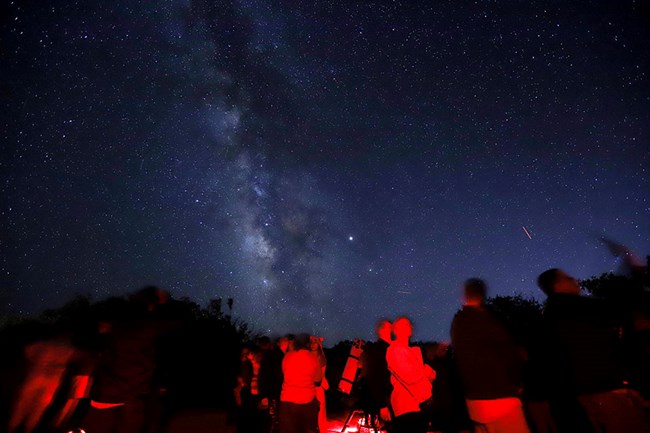
NPS/Bettymaya Foott 
Photo by Joyce Tanihara The Value of Night SkiesThe night skies in national parks are a protected park resource just like plants and animals. They are a natural resource; many natural processes rely on the cycle of light and dark. They are also a cultural resource. People have been viewing the skies for thousands of years and shaping beliefs, traditions, navigation, and wayfinding. Night skies are also a wilderness value. Effects of Light PollutionLight pollution affects more than just astronomers and night sky enthusiasts. It is a widespread challenge across the globe. Sky glow is the increase in the brightness of the night sky that can reduce visibility. Natural sources of sky glow exist, like a bright full moon, but human-made sources are the largest concern. Lights from homes, buildings, parking lots, stadiums, and businesses can increase sky glow and create the "dome" of light seen above populated areas. 
NPS Protecting Night SkiesThough light pollution is created by a multitude of lights, these problems can be resolved one light at a time. Measuring DarknessHow dark is dark? Dark Sky designated locations typically use sky quality meters (SQMs) to measure the darkness of their sky. Readings are usually taken at zenith (the point in the sky directly overhead) and at four other slightly lower points in the sky. SQMs read sky brightness in magnitude per square arcsecond - the higher the number, the darker the sky. The highest possible rating is 23. Your Night SkiesWondering how you can help? Be an advocate for your night skies at home. Here are simple ways you can protect the night.Shield your lights Use full, cut-off light fixtures at your home or business. Existing lights can also be adjusted to point downward or retrofitted with simple metal shrouds. Use lights only when you need them Motion sensors and timers are a great way to turn on or off lights as needed. This costs less, improves security and visibility, and reduces light pollution. Use less light An effective, shielded light fixture can use a smaller wattage bulb and still be effective. Talk to your neighbors Share your appreciation of the night sky with family, friends, neighbors, and community leaders. Encourage action towards reducing light pollution through small, positive changes. DarkSky International provides more information on ways to get involved with night sky protection. 
Stargazing
Stargaze in an International Dark Sky Park! Black Canyon offers night sky viewing opportunities throughout the year. 
Astro Fest 2024
Astro Fest 2024, from September 5-7, celebrates the starry skies at three separate sites along the Gunnison River. 
NPS Night Skies
Learn more about ways the National Park Service protects night skies across the country. |
Last updated: August 5, 2024
